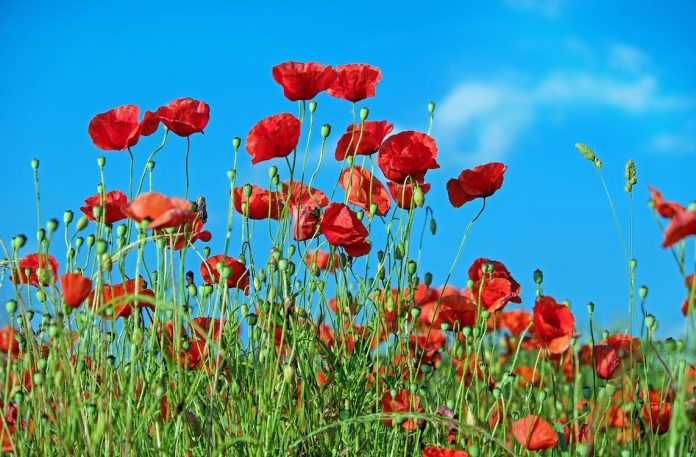
Ginnie Hartley
Saskatchewan Perennial Society
Almost everyone recognizes the red poppy that many people wear on their lapels on Remembrance Day. And many people know that Lieutenant-Colonel John McCrae, who was a Canadian Medical Officer during the First World War, wrote the poem ‘In Flanders Fields’, which speaks of the poppies that bloomed there. However, records indicate that the significance of the poppy can be traced back to the Napoleonic Wars in the early 19th Century, over 110 years before being adopted in Canada. Records from that time indicate how thickly poppies grew over the graves of soldiers in Flanders, France during those wars. These poppies are of the species Papaver rhoeas, the red-flowered corn poppy, which often thrives in areas of disturbed soil.
John McCrae’s poem inspired Madame Anna Guerin of France to found a charity which created poppies made of fabric, to raise funds to help rebuild regions of France torn apart by the First World War. She presented her idea of using the poppy as a symbol of remembrance for fallen soldiers to the Great War Veterans’ Association, the precursor to The Royal Canadian Legion, and it was adopted in 1921.
Some people choose to wear white poppies as an alternative to the red poppy. It symbolises remembrance of all casualties of war, including civilian casualties. But white poppies have been criticised for detracting from the meaning and the funds of the red poppy. Animal Aid in Britain issues a purple poppy as a reminder that both humans and animals are victims of war. In 2018, another unique commemorative poppy, the Khadi poppy, was commissioned by the Royal British Legion to mark the Centenary of the end of the First World War. The red cloth poppy is identical to the usual Remembrance Day poppy, but it is made out of the traditional handwoven Gandhian cloth (Khadi) and honors the British Indian soldiers who fought in the World Wars.
In 2014 a sea of 888,246 ceramic red poppies were used to form a weeping wall of red at the Tower of London, UK. This art installation was made to mark the 100 years since the start of World War One, and for four years it was moved and installed on other cathedrals in Britain.
Of course, poppies have uses other than for remembrance of the fallen. Their beautiful colors (not only red) make them a popular addition to flower beds. Growing them can be as simple as planting seeds in average, or even poor soil in a sunny location. Roots can also be divided, and this should be done in the fall.
Ancient Egyptian doctors would give poppy seeds to their patients to relieve pain. The Minoan civilization (~2700 – 1450 BC) grew poppies for their seeds and used a milk, opium and honey mixture to calm crying babies. The seeds contain small quantities of both morphine and codeine. Seeds that are harvested about twenty days after the flower has opened are non-narcotic because then the morphine is no longer present. Seed capsules of the opium poppy can be processed chemically to produce heroin for medicinal use and for the illegal drug trade.
Poppy seeds are also a rich source of thiamin, folate and several essential minerals including calcium, iron, magnesium, manganese, phosphorus and zinc. They are often used as a spice and decoration for baked goods. The seeds can also be ground and used as a filling for pastries. They also produce an oil which has no odor and a pleasant taste, and is less likely than other oils to become rancid. The oil can be used for cooking, and also as a skin moisturizer.
The petals contain a red dye which is used in some medicines and wines. The dried petals are occasionally used to give color to potpourri.
So when you pin on your Remembrance Day poppy, remember that it is not only a symbol of memory, sleep and death, but also is ubiquitous in the flower bed, the pharmacy and the kitchen.Ginnie Hartley is a retired Speech-Language Pathologist who loves gardening almost as much as she loves words. This column is provided courtesy of the Saskatchewan Perennial Society (SPS; saskperennial@hotmail.com ). Check our website (www.saskperennial.ca) or Facebook page (www.facebook.com/saskperennial) for a list of upcoming gardening events.

